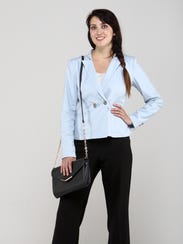Then, one day, they put on a graduation gown and enter the job market where wardrobe norms can be a bit less lenient.
"All of a sudden, they need to be wearing clothes that are tailored properly and that are pressed and professional," says Peggy Noe Stevens, author of "Professional Presence: A Four-Part Program for Building your Personal Brand" and president of Peggy Noe Stevens & Associates, a Louisville, Ky., image consulting firm.
"Most of them have no idea where to begin. Many of them don't own a single item that could be worn into an interview."
And buying that one great interview suit — a rite of passage 10 years ago — just doesn't cut it anymore. "The professional wardrobe has changed," says Stevens. "It's all over the board. Some companies are more casual; others are still suit and tie. ... You want to dress appropriately, but you want to do more than that. You want to dress like you belong."
If that task seems daunting, it doesn't have to be. "Dressing for an interview takes some thought and some homework," says Wendy Jacobs, vice president and regional employment manager for BB&T. Jacobs interviews nearly 100 job candidates a year and also talks to business students about interviewing etiquette at local colleges. "I tell students to just pick up the phone," says Jacobs. "Call human resources and ask about the dress code. It's never wrong to do that."
In other words, your clothes can set you apart. You want them to do that in a positive way.

Hannah Fulkerson(Photo: By Michael Clevenger/The C-J)
To mak! e sure that happens, here's a quick list of interview dressing do's and don'ts:
1. BUILD YOUR GROWN-UP WARDROBE. Start assembling the makings of an adult closet now. "I tell students to start thinking about a professional wardrobe before or as soon as they graduate," says Stevens. "You need that suit, yes, but you should also think in terms of good basics. Good pants. A few good tailored shirts. Nice shoes."
2. LEARN HOW TO IRON. "I can't tell you how many people mention young people coming in looking rumpled," says Jacobs. "I always say, 'Neat, clean and pressed. It doesn't have to be expensive. But you have to look polished and presentable.' "
3. TAKE A GOOD LOOK IN THE MIRROR — OR GET A PROFESSIONAL OPINION. Extremely long hair, tattoos, nail art, wild hair colors and even facial hair for guys may be commonplace on campuses, but they're not as welcome in every workplace. "I tell grads to book a consultation and talk to a stylist," says Stevens. "You want to look polished and relevant." Whether or not you cut or color your hair, it's wise to go into an interview with a fairly conservative beauty look.
4. PUT YOUR BEST FOOT FORWARD — AND NOT IN SANDALS. The experts agree that crazy, colorful, sexy shoes don't scream 'serious job candidate.' Whether it's a pair of wildly colored men's athletic shoes or chunky platform sandals, bold footwear is a step in the wrong direction. "Men should be wearing loafers or oxfords; women should stick with classic pumps or conservative peep toes," says Chris Fulkerson, president of VIP studios, a local image consulting agency.
5. PAY ATTENTION TO FIT. Buying grown-up clothes is a good start, but don't stop there: Make sure they fit properly. Take it to a tailor. Try it on for your parents. "You want to make sure the fit is precise," says Fulkerson, whose two college-age daughters recently found jobs. After all, anyone who takes the time to get the fit just right would probably take the time to attend to a whole host of other details tha! t an empl! oyer is looking to delegate.
6. MOM MAY BE WRONG: YOU PROBABLY CAN SKIP THE PANTYHOSE. Up until two or three years ago, pantyhose was a conservative workplace standard — even in the sweltering summer. Good news for recent grads: "Hose are not required anymore," says Jacobs. "It's worth a call to HR, but our bank is very conservative and we've changed our dress code."
7. AS LONG AS YOU DON'T LOOK SEXY. Bare legs may be OK, but not if you're showing too much of them. "One of the biggest mistakes women can make is dressing too sexy," says Jacobs. Hemlines should hit right above the knee and cleavage is a no-no. The same goes for clingy or sheer fabrics and "too much bling."
8. DON'T DRESS LIKE A CLONE. You want your clothes to be neat. Clean. Pressed. Well-fitting. But that doesn't mean they have to be boring. So forget those images of navy blue suits, pumps and suntan hose — or gray suits and rep ties — and find work clothes that you also actually like to wear. "If you feel good in your clothes, you project confidence," says Jacobs. And that, regardless of where you're interviewing, always works.
THE LOOK THAT GOT THE JOB
Sydney Fulkerson, a University of Kentucky senior in merchandising and business, was recently offered an internship with a small Los Angeles fashion label. Her look:
-- A sophisticated (not sexy) leather skirt and top signal an interest in fashion.
-- This sleek jacket looks polished and pulled together.
-- An envelope clutch adds a finishing touch and organizes papers.
ANOTHER LOOK THAT LANDED THE JOB
Hannah Fulkerson, who recently completed her master's degree in art therapy at the University of Louisville, just took a job as an art therapist working with children in Boston.
-- Soft blue (jacket) is approachable.
-- Black pants look professional, but not fussy.
-- Shoulder bag and classic pumps are practical and pulled together.
No comments:
Post a Comment